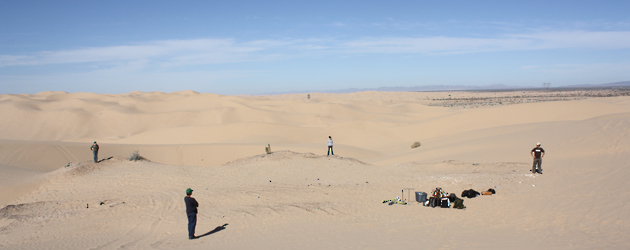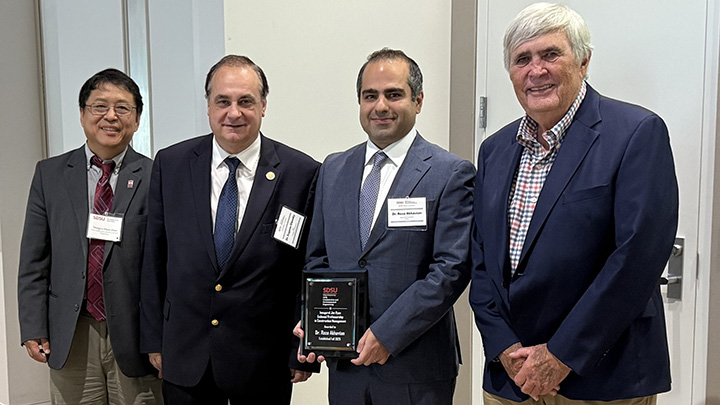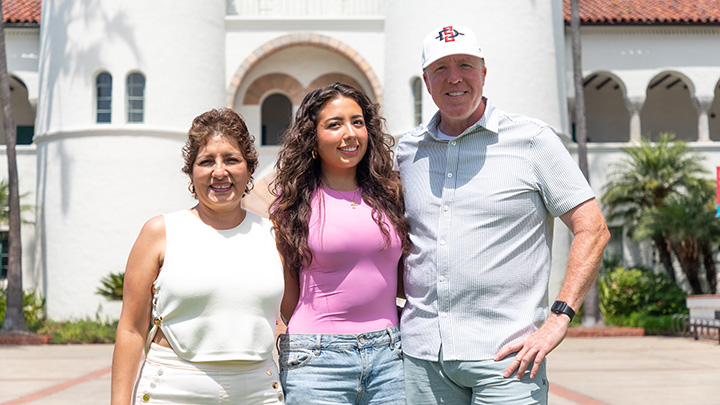Mapping Fort Zinderneuf
Alumni join SDSU professor Seth Mallios for an archaeology project at a desert film location.

“It's like the Sahara out here.”
That was Seth Mallios’ take on his trek across the Buttercup Dunes of eastern Imperial County where the constantly shifting sands create a vast and ever-changing landscape resembling northern Africa.
It’s where the chairman of SDSU’s anthropology department led an expedition last month to map a location frequented more than 70 years earlier by a group of San Diego State student filmmakers.
Other-worldly experience
“It's other-worldly,” Mallios observed. “I think it makes a lot of sense why Return of the Jedi was filmed just a mile from here and Stargate was filmed around here as well because this really looks like at least another continent, if not another planet."
It was also where desert scenes for the 1939 Hollywood classic, Beau Geste, starring Gary Cooper, were filmed. When the French Foreign Legion-themed story became a hit, a group of San Diego State students used the abandoned set to make their own parody of the movie which was shown on campus in 1940.
Recently, while working on a documentary about the French Foreign Legion in popular culture, film historian and filmmaker, Frank Thompson, located a copy of the student film and managed to rediscover the location of the set of Fort Zinderneuf used in both the student parody Beau Geste and the 1939 Hollywood version. There wasn’t much left, but the fort site could be identified by a widely scattered debris field filled with demolition remnants, broken glass and shell casings from prop rifles.
“I got a call from Seth who said he wanted to do an archaeological survey of the area and so we just talked over the possibilities of my leading him to the spot because certainly it could be found — I found it,” Thompson said. “But it's easier if somebody can just tell you where it is.”
Mallios, who is working on a book involving San Diego State history, was interested in the location because of its ties to the university through the student film. Having never worked at a desert site before, he also appreciated the opportunity for a new professional challenge.
“The first thing was I wanted to see it — just for my own eyes to see what it looked like,” he said.
“But the second thing was wondering if we could come up with a parameter of the fort. If it weren't for Frank, we wouldn't know where this is. What we're doing is recording the parameters and then we're going to fill out a site form that is tied to a global positioning system so people will be able to find this spot. If the dunes blow over this and it completely disappears, we'll still be able to find it from the map we're making today."
Definitely different
Marking the site perimeter with pin flags was SDSU alumna Hillary Sweeney, lab manager for the North American Archaeology Lab. Once the perimeter was established, she and the team began identifying clusters of artifacts.
“What a cluster consists of is usually more than two or three shards of glass or bullet cartridges or the telephone poles that have been out here that outline the corners of the fort foundation,” she explained.
“We're going to go and take pictures of the artifacts, take GPS shots of the scatters and then describe each artifact we find within that scatter since we can't take it back with us to the lab."
The fort site is located on government land, so special permits are needed to study the location. The archaeological team was not allowed to do any digging or remove any artifacts from the site.
“It's definitely different,” said Sweeney. “I've dug up on Palomar Mountain and the mountains are vastly different from out here. I've never done a survey like this out in the desert and for a movie set to have been built out here, especially back then, I think is incredible, so I'm excited to see what our results will be with the artifacts we find today.”
The stuff lying around
Besides the shell casings and broken water bottles, the team found the heel of an old boot, which may have been part of a film costume, and pieces of what might have been the flooring from the fort.
“It's amazing,” said David Caterino, director of the South Coastal information Center. “I didn't think there would be that much stuff lying around. It's just amazing that stuff is still here after all those years.”
Probably the most amazing discovery the team made was the actual outline of the foundation of the fort. It was marked by wooden posts still firmly planted in the sand.
“It's all still in place,” Mallios exclaimed. “The actual footprint of the fort! What you're looking at is the original architecture that went into it. Granted, this whole area has been bulldozed and modern campfires have been set all over the place, but at the same time, this is the exact layout of the fort and that layout was done very deliberately in constructing the set.
“I didn't think we would be able to find anything intact. What gets me so excited is it's intact even through decades and decades of wind blowing sand back and forth, even through decades and decades of dune buggies blowing over this area that we have intact parts of the fort.”
Further excavation?
Despite his excitement by what the team found, Mallios is unsure whether he will return to further excavate the old film set. Although he enjoys leading teams of students in digs at interesting sites, the Fort Zinderneuf location may be left at only having been mapped.
“I'm definitely looking for new projects, but I don't know if this is it,” Mallios said.
“I usually do summer field schools which would be a little difficult out here, but at the same time, this is an amazing experience. The other concern is if we were to do any sort of excavation, to have to battle moving sand dunes is very tough. It's one thing I've never dealt with. I've dealt with rivers and tides before, but I've never dealt with sand covering a site, so I don't know exactly how we'd do it.”
As excited as Mallios and his team were about what they discovered at the fort site, no one is more thrilled than Thompson about having the location validated and mapped. Beau Geste was the movie he saw as a youngster that triggered his interest in film and inspired his documentary involving the French Foreign Legion.
“It's hard to explain to somebody who doesn't get it, but to me it's the most fun I could possibly have,” said the film historian.
“Gary Cooper was standing right there,” Thompson continued, pointing to the area identified as the location of the gate to the movie-set fort, “and you can see those little mountains right behind his back every time they show him at his place in the fort. This is exactly where it was.
“Beau Geste is the movie that changed my life, and the fact that I found it is just amazing to me. I found Fort Zinderneuf when nobody else knew where it was and now to have these people showing similar enthusiasm for it is just great. It's gratifying. It's a miracle. I'm having the time of my life!”
Frank Thompson is now working on a documentary of the San Diego State student parody of Beau Geste. He hopes to one day be able to show his film on campus along with the 1940 student movie.
Related Content


